Submitted:
03 July 2023
Posted:
03 July 2023
You are already at the latest version
Abstract
Keywords:
1. Introduction
2. Materials and Methods
2.1. Study area
2.2. Data
2.3. Methods
2.3.1. Snow cover frequency
2.3.2. Elevation, slope and aspect data processing
3. Results
3.1. Spatial distribution of snow cover
3.1.1. Annual mean SCF
3.1.2. Mean SCF in spring
3.1.3. Mean SCF in summer
3.1.4. Mean SCF in autumn
3.1.5. Mean SCF in winter
3.2. Snow cover distribution with elevation
3.3. Snow cover distribution with longitude and latitude
3.4. Snow cover distribution with aspect
3.5. Snow cover distribution with slope
4. Discussion
5. Conclusion
Author Contributions
Funding
Acknowledgments:
References
- Barnett: T., P.; Adam, J.C.; Lettenmaier, D.P. Potential impacts of a warming climate on water availability in snow-dominated regions. Nature 2005, 438, 303–309. [Google Scholar] [CrossRef] [PubMed]
- Armstrong, R.L.; Brodzig, M.J. Recent Northern Hemisphere snow extent: a comparison of data derived from visible and microwave satellite sensors. Geophys. Res. Lett. 2001, 28, 3673–3676. [Google Scholar] [CrossRef]
- Allchin, M.I.; Déry, S.J. A spatio-temporal analysis of trends in Northern Hemisphere snow-dominated area and duration, 1971–2014. Ann. Glaciol. 2017, 58, 21–35. [Google Scholar] [CrossRef]
- Brown, R.D.; Robinson, D.A. Northern Hemisphere spring snow cover variability and change over 1922–2010 including an assessment of uncertainty. The Cryosphere, 2011, 5, 219–229. [Google Scholar] [CrossRef]
- Déry, S.J.; Brown, R.D. Recent Northern Hemisphere snow cover extent trends and implications for the snow-albedo feedback. Geophys. Res. Lett. 2007, 34, 60–64. [Google Scholar] [CrossRef]
- Choi, G.; Robinson, D.A.; Kang, S. Changing Northern Hemisphere snow seasons. J. Clim. 2010, 23, 5 305–5 310. [Google Scholar] [CrossRef]
- Savoie, M.H.; Armstrong, R.L.; Brodzik, M.J.; et al. Atmospheric corrections for improved satellite passive microwave snow cover retrievals over the Tibet Plateau. Remote Sens. Environ. 2009, 113, 2661–2669. [Google Scholar] [CrossRef]
- Yao, T.; Thompson, L.; Yang, W.; et al. Different glacier status with atmospheric circulations in Tibetan Plateau and surroundings. Nat. Clim. Change, 2012, 2, 663–667. [Google Scholar] [CrossRef]
- Immerzeel, W.W.; Van Beek, L.P.H.; Bierkens, M.F.P. Climate change will affect the Asian water towers. Science 2010, 328, 1382–1385. [Google Scholar] [CrossRef]
- Li, X.; Long, D.; Scanlon, B.R.; et al. Climate change threatens terrestrial water storage over the Tibetan Plateau. Nat. Clim. Change, 2022, 12, 801–807. [Google Scholar] [CrossRef]
- Ueno, K.; Tanaka, K.; Tsutsui, H.; et al. Snow cover conditions in the Tibetan Plateau observed during the winter of 2003/2004. Arct. Antarct. Alp Res. 2007, 39, 152–164. [Google Scholar] [CrossRef]
- Pu, Z.; Xu, L.; Salomonson, V.V. MODIS/Terra observed seasonal variations of snow cover over the Tibetan Plateau. Geophys. Res. Lett. 2007, 34, 137–161. [Google Scholar] [CrossRef]
- Immerzeel, W.W.; Droogers, P.; De Jong, S.M.; et al. Large-scale monitoring of snow cover and runoff simulation in Himalayan river basins using remote sensing. Remote Sens. Environ. 2009, 113, 40–49. [Google Scholar] [CrossRef]
- Li, W.; Guo, W.; Qiu, B.; et al. Influence of Tibetan Plateau snow cover on East Asian atmospheric circulation at medium-range time scales. Nat. Commun. 2018, 9, 4243. [Google Scholar] [CrossRef] [PubMed]
- Liu, Y.M.; Bao, Q.; Duan, A.M.; et al. Recent progress in the impact of the Tibetan Plateau on climate in China. Adv. Atmos. Sci. 2007, 24, 1060–1076. [Google Scholar] [CrossRef]
- Duan, A.M.; Wu, G.X.; Liu, Y.M.; et al. Weather and climate effects of the Tibetan Plateau. Adv. Atmos. Sci. 2012, 29, 978–992. [Google Scholar] [CrossRef]
- Yao, T.; Bolch, T.; Chen, D.; et al. The imbalance of the Asian water tower. Nat. Rev. Earth Environ. 2022, 3, 618–632. [Google Scholar] [CrossRef]
- Nie, Y.; Pritchard, H.D.; Liu, Q.; et al. Glacial change and hydrological implications in the Himalaya and Karakoram. Nat. Rev. Earth Environ, 2021, 2, 91–106. [Google Scholar] [CrossRef]
- Immerzeel, W.W.; Lutz, A.F.; Andrade, M.; et al. Importance and vulnerability of the world’s water towers. Nature 2020, 577, 364–369. [Google Scholar] [CrossRef]
- You, Q.; Wu, T.; Shen, L.; et al. Review of snow cover variation over the Tibetan Plateau and its influence on the broad climate system. Earth Sci. Rev. 2020, 201, 103043. [Google Scholar] [CrossRef]
- Li, Y.; Chen, Y.; Li, Z. Climate and topographic controls on snow phenology dynamics in the Tienshan Mountains, Central Asia. Atmos. Res. 2020, 236, 104813. [Google Scholar] [CrossRef]
- Tong, J.; Déry, S.J.; Jackson, P.L. Topographic control of snow distribution in an alpine watershed of western Canada inferred from spatially-filtered MODIS snow products. Hydrol. Earth Syst. Sci. 2009, 13, 319–326. [Google Scholar] [CrossRef]
- Jain, S.; Goswami, A.; Saraf, A. Role of elevation and aspect in snow distribution in Western Himalaya. Water Resour. Manag. 2009, 23, 71–83. [Google Scholar] [CrossRef]
- Shrestha, A.; Agrawal, N.; Alfthan, B.; et al. The Himalayan Climate and Water Atlas. ICIMOD. 2015.
- Gurung, D.R.; Maharjan, S.B.; Shrestha, A.B.; et al. , Climate and topographic controls on snow cover dynamics in the Hindu Kush Himalaya. Int. J. Climatol. 2017, 37, 3873–3882. [Google Scholar] [CrossRef]
- Desinayak, N.; Prasad, A.K.; El-Askary, H.; et al. Snow cover variability and trend over the Hindu Kush Himalayan region using MODIS and SRTM data. Ann. Geophys. 2022, 40, 67–82. [Google Scholar] [CrossRef]
- Gao, J.; Williams, M.W.; Fu, X.D.; et al. , Spatiotemporal distribution of snow in eastern Tibet and the response to climate change. Remote Sens. Environ. 2012, 121, 1–9. [Google Scholar] [CrossRef]
- Chu, D. Spatiotemporal variability of snow cover on Tibet, China using MODIS remote-sensing data. Int. J. Remote Sens. 2018, 39, 6784–6804. [Google Scholar] [CrossRef]
- Pu, Z.; Xu, L. MODIS/Terra observed snow cover over the Tibet Plateau: distribution, variation and possible connection with the East Asian Summer Monsoon (EASM). Theor. Appl. Climatol. 2009, 97, 265–278. [Google Scholar] [CrossRef]
- Basang, D.; Barthel, K.; Olseth, J. Satellite and ground observations of snow cover in Tibet during 2001–2015. Remote Sens. 2017, 14, 9, 1201. [Google Scholar] [CrossRef]
- Cai, D.; Guo, N.; Wang, X.; et al. The spatial and temporal variations of snow cover over the Qilian Mountains based on MODIS data. Journal of Glaciology and Geocryology, 2009, 31, 1028–1036. [Google Scholar]
- Yang, C.J.; Zhao, Z.J.; Ni, J.; et al. Temporal and spatial analysis of changes in snow cover in western Sichuan based on MODIS images. Sci. China Earth Sci. 2011, 41, 1743–1750. [Google Scholar] [CrossRef]
- Lou, M.Y.; Liu, Z.H.; Lou, S.M.; et al. Temporal and spatial distribution of snow cover in Xinjiang from 2002 to 2011. Journal of Glaciology and Geocryology, 2013, 35, 1095–1102. [Google Scholar]
- Lin, J.T.; Feng, X.Z.; Xiao, P.F.; et al. Spatial and temporal distribution of snow cover in mountainous area of Manasi River Basin based on MODIS. Remote Sensing Technology and Application, 2011, 26, 469–475. [Google Scholar]
- Dou, Y.; Chen, X.; Bao, A.M.; et al. Study of the temporal and spatial distribute of the snow cover in the Tianshan Mountains, China. Journal of Glaciology and Geocryology, 2010, 32, 28–34. [Google Scholar]
- Lin, J.T.; Feng, X.Z.; Xiao, P.F.; et al. The spatial and temporal variations of snow cover over the Qilian mountains based on MODIS data. Journal of Glaciology and Geocryology, 2011, 33, 971–978. [Google Scholar]
- Körner, C.; Jetz, W.; Paulsen, J.; et al. A global inventory of mountains for bio-geographical applications. Alpine Bot. 2017, 127, 1–15. [Google Scholar] [CrossRef]
- Zhang, Y.L.; Li, B.Y.; Zheng, D. A discussion on the boundary and area of the Tibetan Plateau in China. Geographical Research, 2002, 21, 1–8. [Google Scholar]
- Sun, H.L.; Zheng, D. Formation, Evolution and Development of Qinghai-Xizang (Tibetan) Plateau (in Chinese). Guangdong Science & Technology Press, 1998, 231–296.
- Hall, D.K.; Riggs, G.A.; Salomonson, V.V.; et al. MODIS snow-cover products. Remote Sens. Environ. 2002, 83, 181–194. [Google Scholar] [CrossRef]
- Hall, D.K.; Riggs, G.A.; Foster, J.L.; et al. Development and evaluation of a cloud-gap-filled MODIS daily snow-cover product. Remote Sens. Environ. 2010, 114, 496–503. [Google Scholar] [CrossRef]
- Klein, A.G.; Barnett, A.C. Validation of daily MODIS snow cover maps of the Upper Rio Grande River basin for the 2000-2001 snow year. Remote Sens. Environ. 2003, 86, 162–176. [Google Scholar] [CrossRef]
- Liang, T.; Zhang, X.; Xie, H.; et al. Toward improved daily snow cover mapping with advanced combination of MODIS and AMSR-E measurements. Remote Sens. Environ. 2008, 112, 3750–3761. [Google Scholar] [CrossRef]
- Huang, X.; Liang, T.; Zhang, X.; et al. Validation of MODIS snow cover products using Landsat and ground measurements during the 2001–2005 snow seasons over northern Xinjiang, China. Int. J. Remote Sens. 2011, 32, 133–152. [Google Scholar] [CrossRef]
- Wang, X.; Xie, H.; Liang, T. Evaluation of MODIS snow cover and cloud mask and its application in Northern Xinjiang, China. Remote Sens. Environ. 2008, 112, 1497–1513. [Google Scholar] [CrossRef]
- Li, J.; Zheng, B.; Yang, X.; et al. Glaciers in Tibet (in Chinese). Beijing: Science Press, 1986.
- Qin, D.; Liu, S.; Li, P. Snow cover distribution, variability, and response to climate change in western China. J. Clim. 2006, 19, 1820–1833. [Google Scholar]
- Shrestha, A.B.; Joshi, S.P. ; Snow cover and glacier change study in Nepalese Himalaya using remote sensing and geographic information system. Journal of Hydrology & Meteorology, 2009, 6, 26–36. [Google Scholar]
- Lhakpa, D.; Fan, Y.; Cai, Y. Continuous Karakoram glacier anomaly and its response to climate change during 2000–2021. Remote Sens. 2022, 14, 6281. [Google Scholar] [CrossRef]
- Huang, X.D.; Deng, J.; Wang, W.; et al. Impact of climate and elevation on snow cover using integrated remote sensing snow products in Tibetan Plateau. Remote Sens. Environ. 2017, 190, 274–288. [Google Scholar] [CrossRef]
- Bhattacharya, A.; Bolch, T.; Mukherjee, K.; et al. High Mountain Asian glacier response to climate revealed by multi-temporal satellite observations since the 1960s. Nat. Commun. 2021, 12, 4133. [Google Scholar] [CrossRef]
- Chen, X.; Long, D.; Liang, S.; et al. Developing a composite daily snow cover extent record over the Tibetan Plateau from 1981 to 2016 using multisource data. Remote Sens. Environ. 2018, 215, 284–299. [Google Scholar] [CrossRef]
- Choudhury, A.; Yadav, A.C.; Bonafoni, S. A response of snow cover to the climate in the Northwest Himalaya (NWH) using satellite products. Remote Sens. 2021, 13, 655. [Google Scholar] [CrossRef]
- Tang, B.H.; Shrestha, B.; Li, Z.L.; et al. Determination of snow cover from MODIS data for the Tibetan Plateau region. Int. J. Appl. Earth Obs. 2012, 21, 356–365. [Google Scholar] [CrossRef]
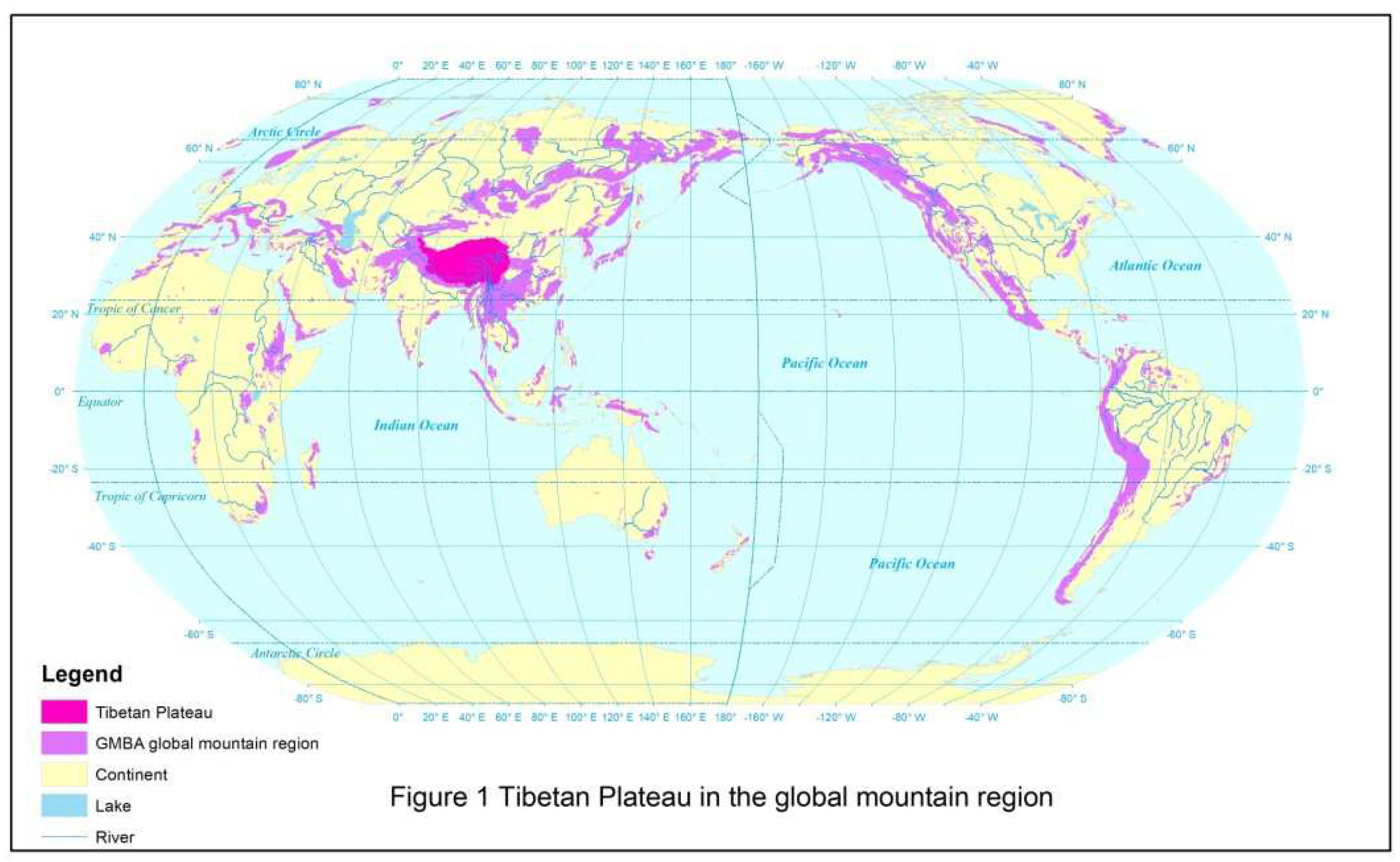
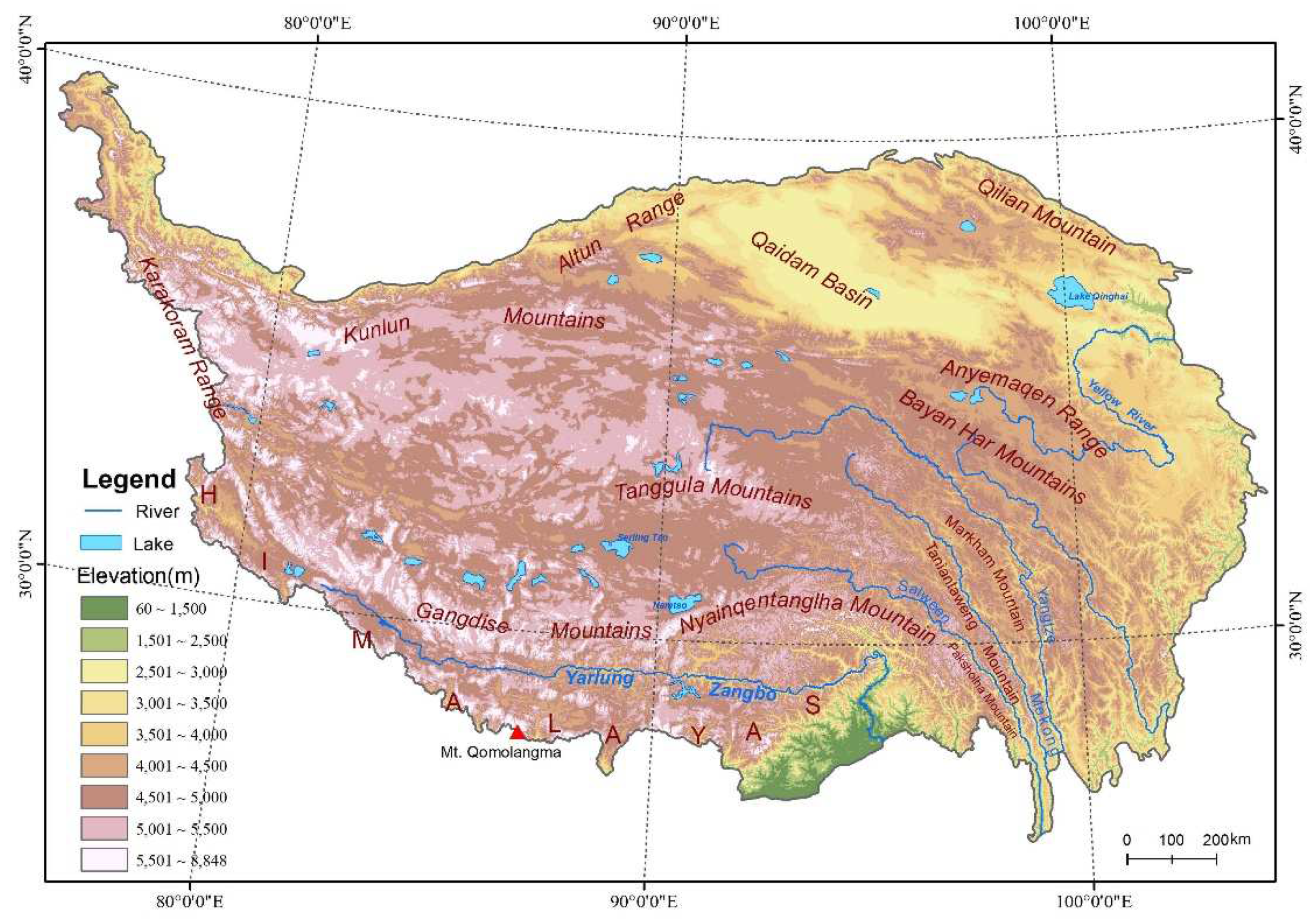
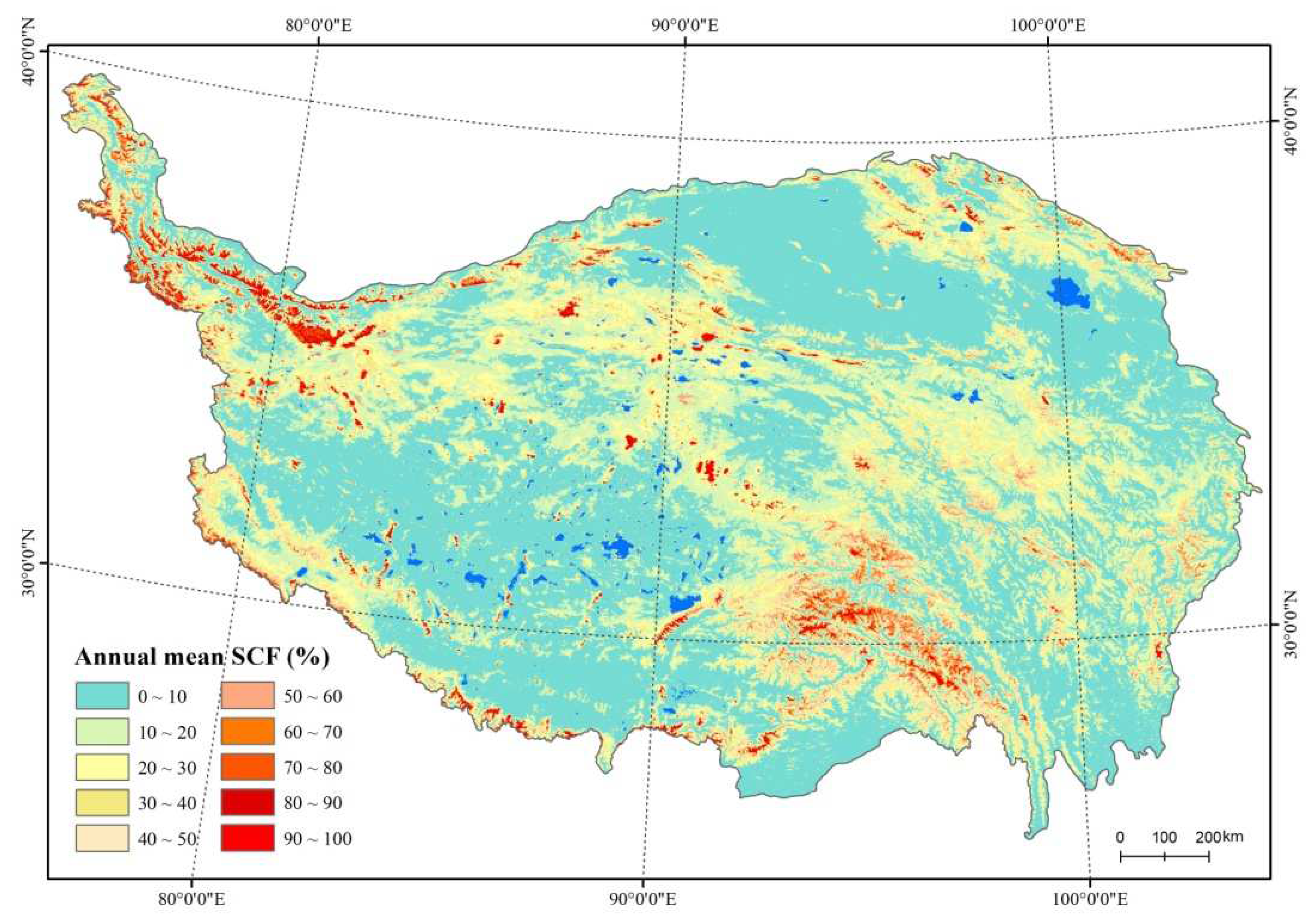
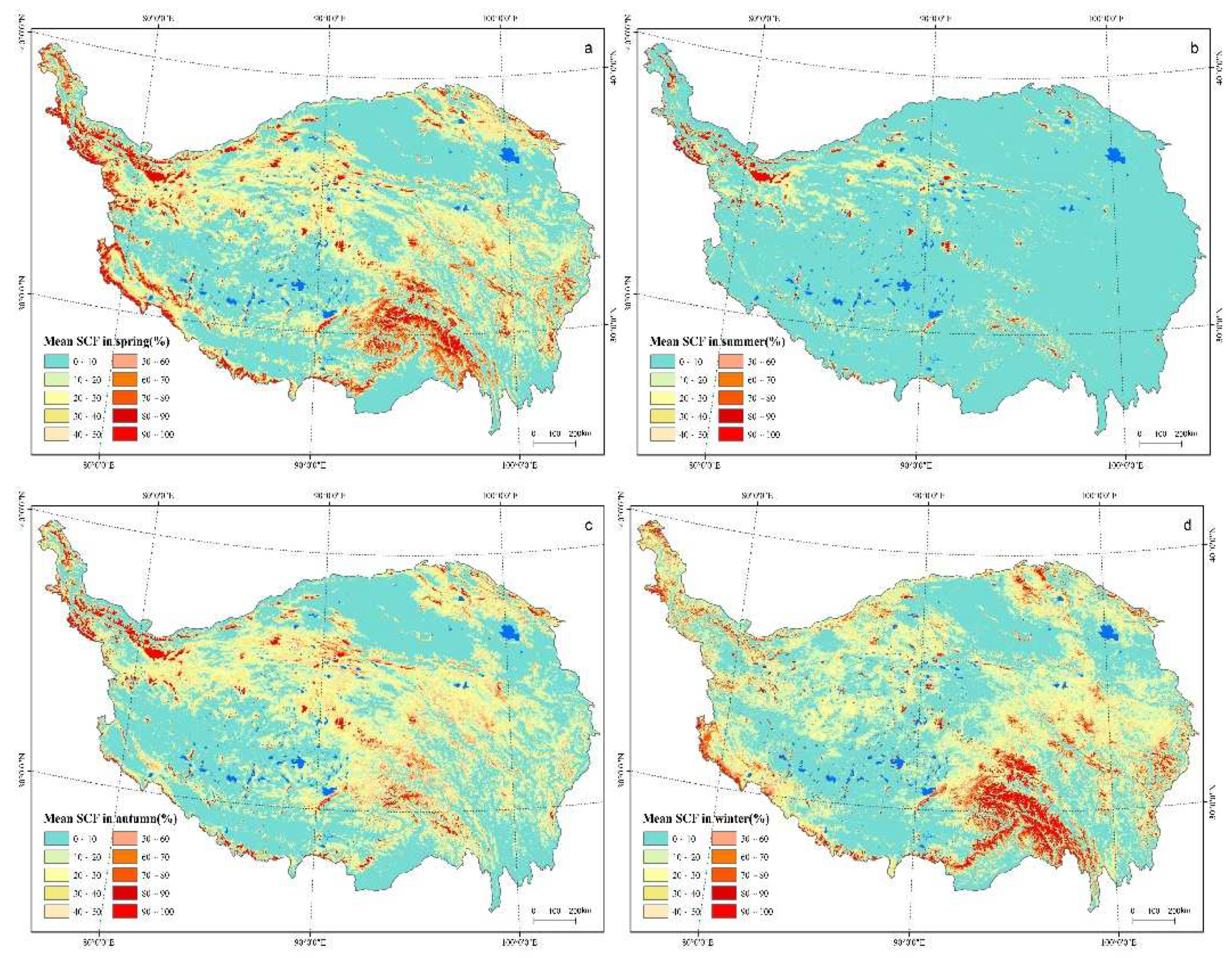
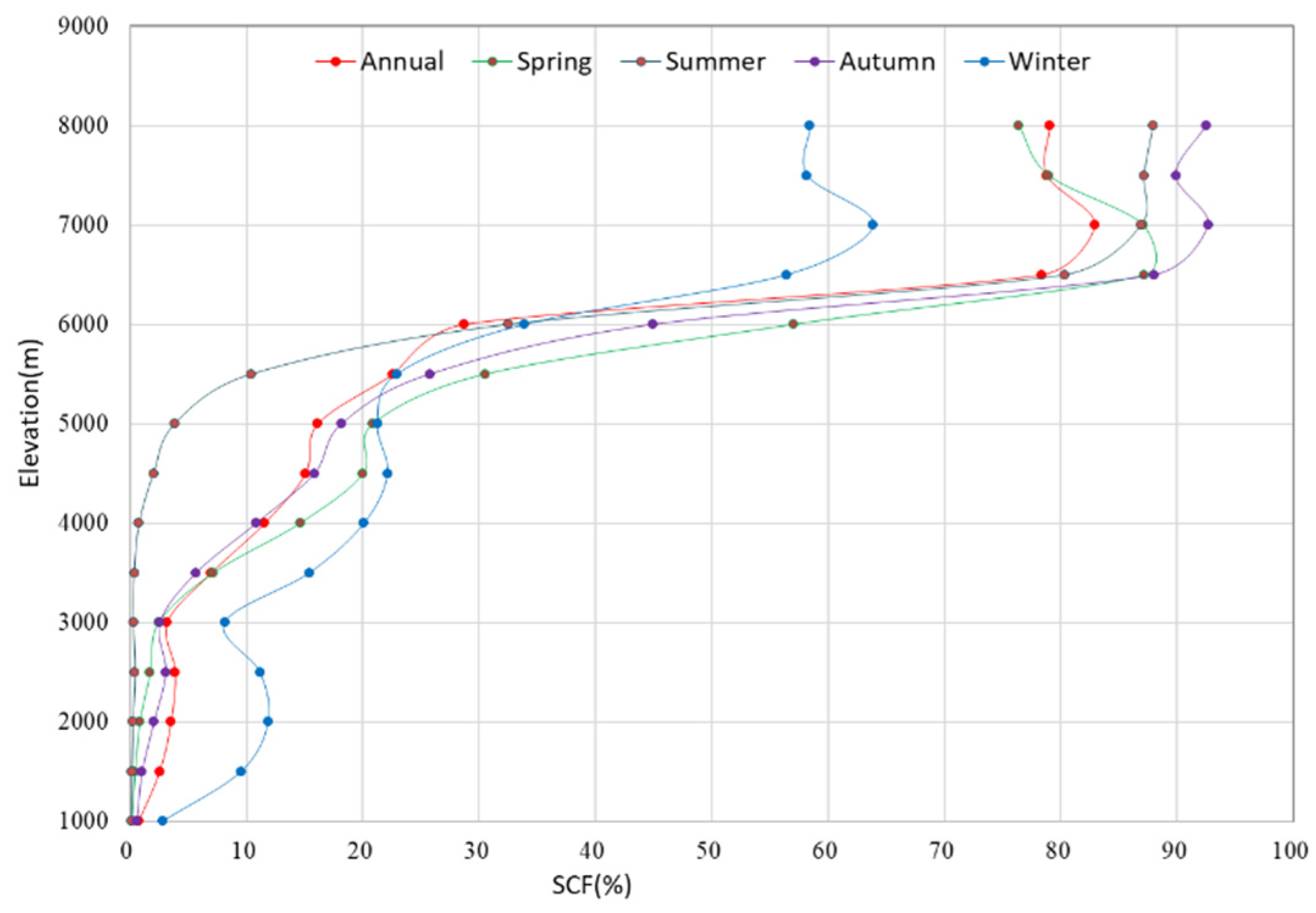
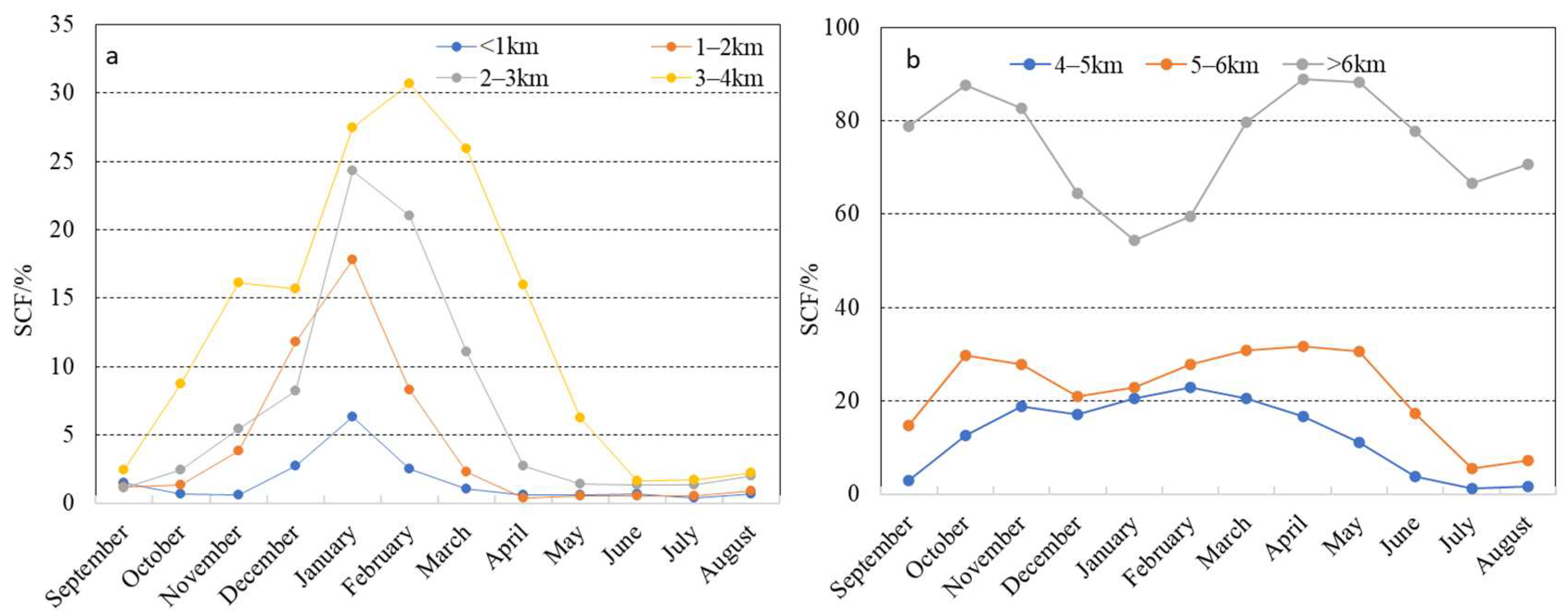
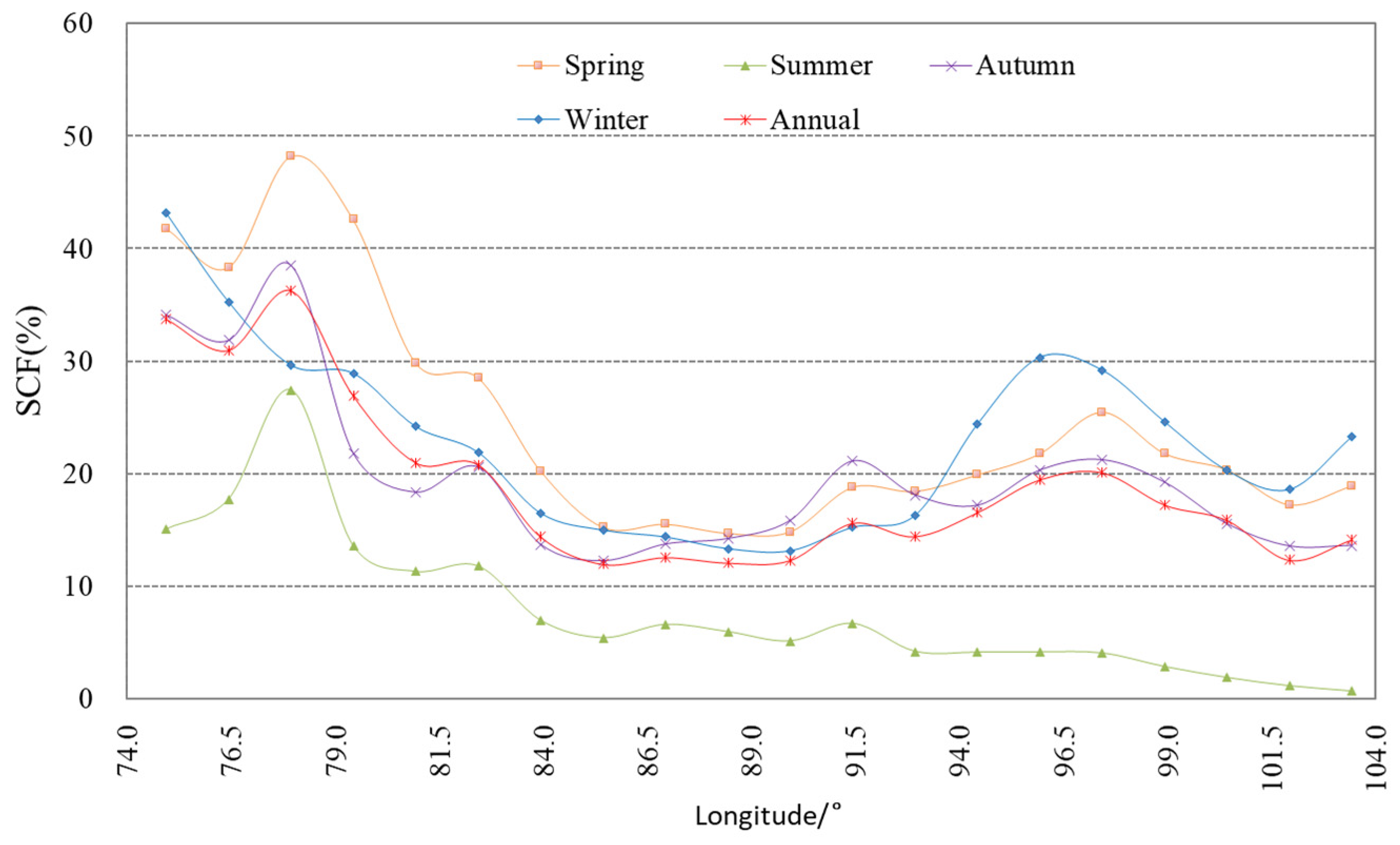
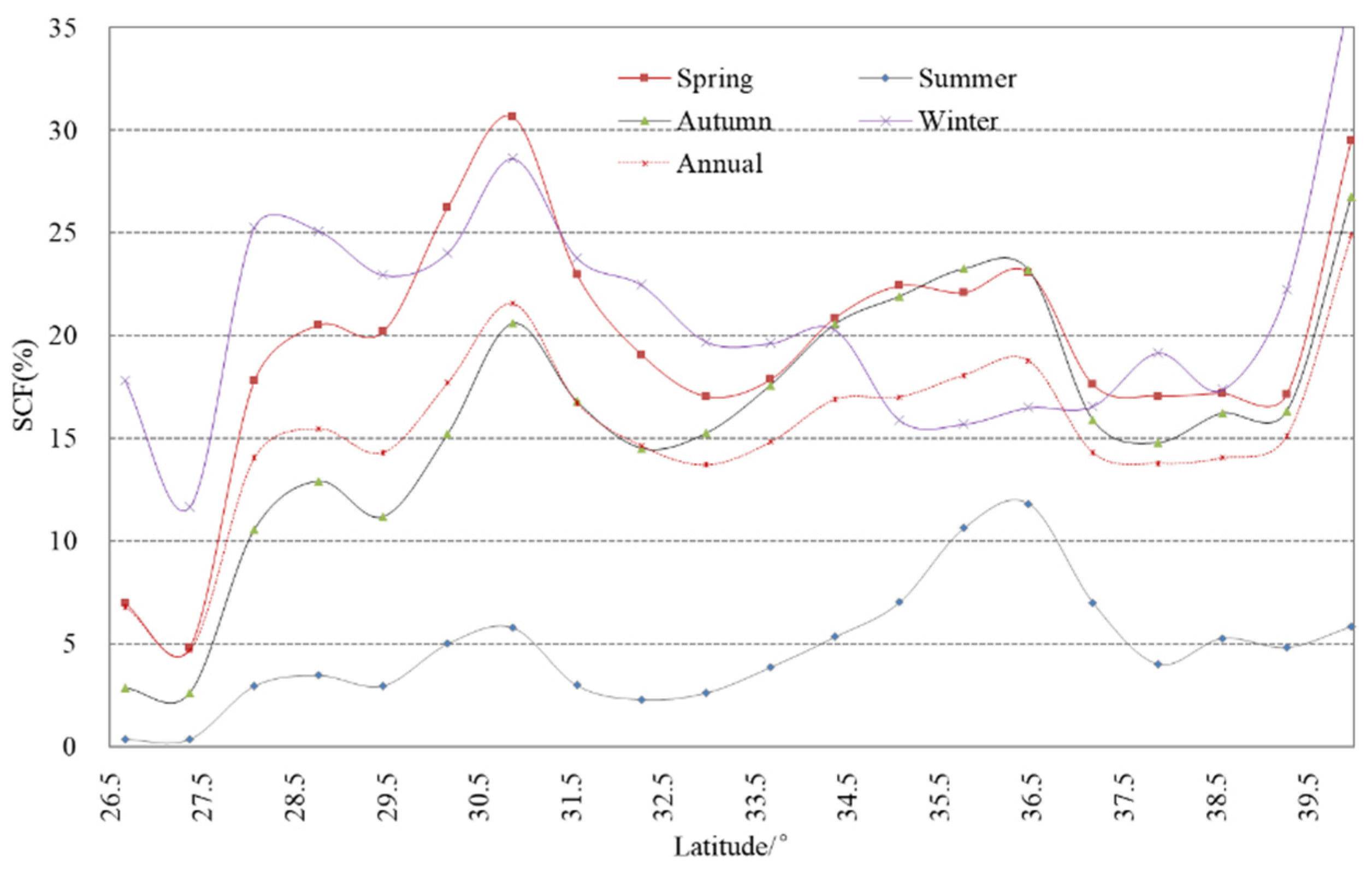
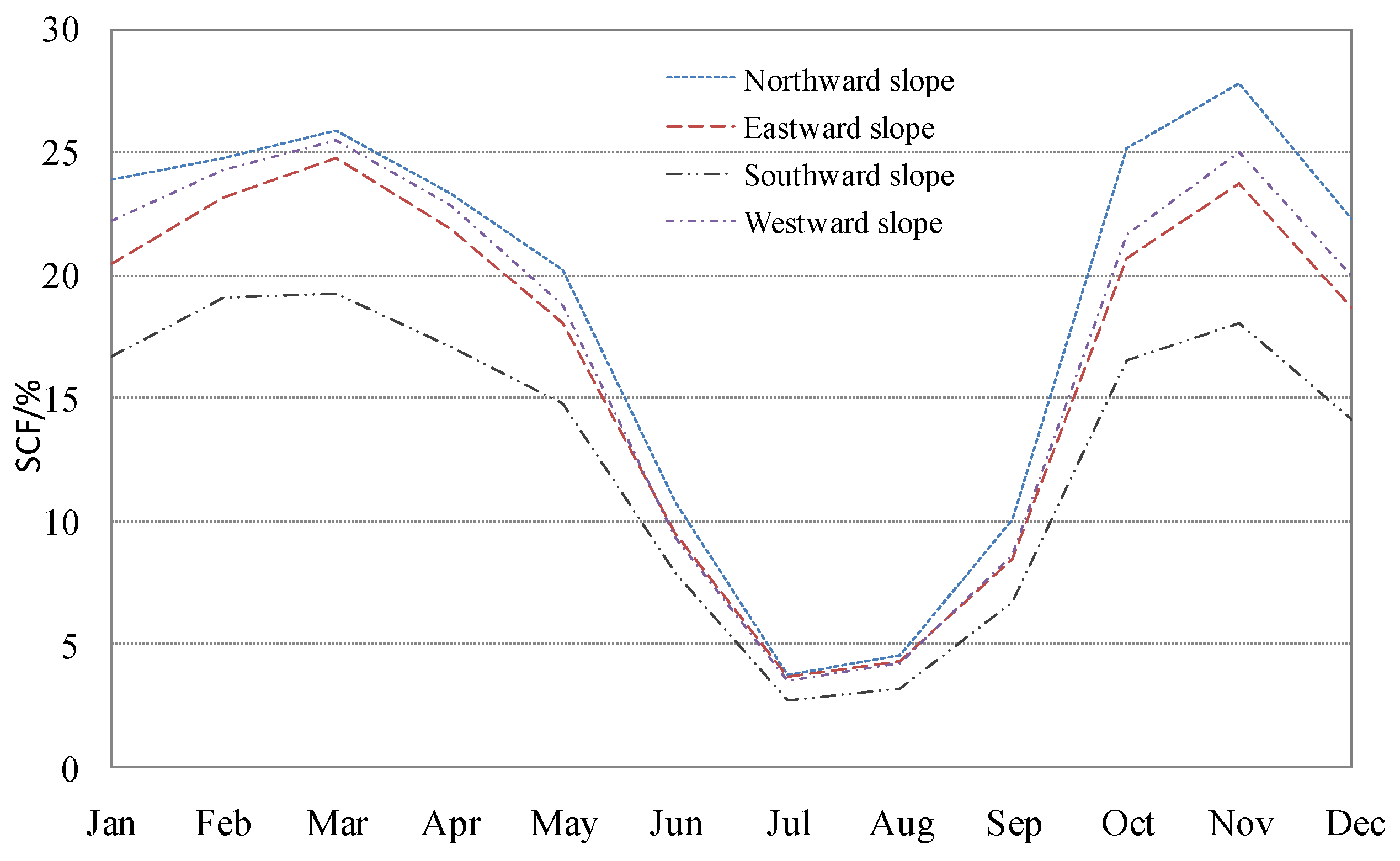
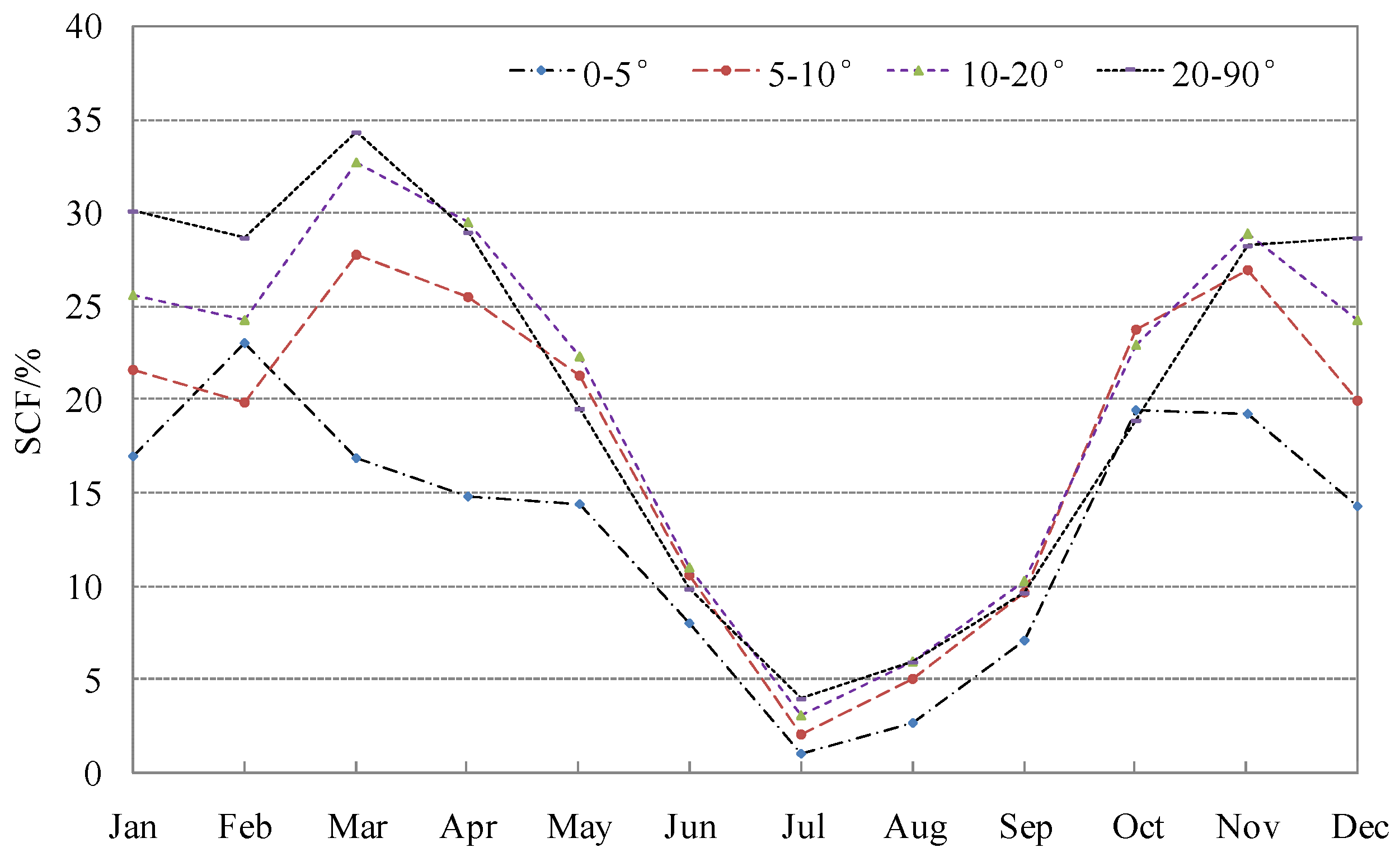
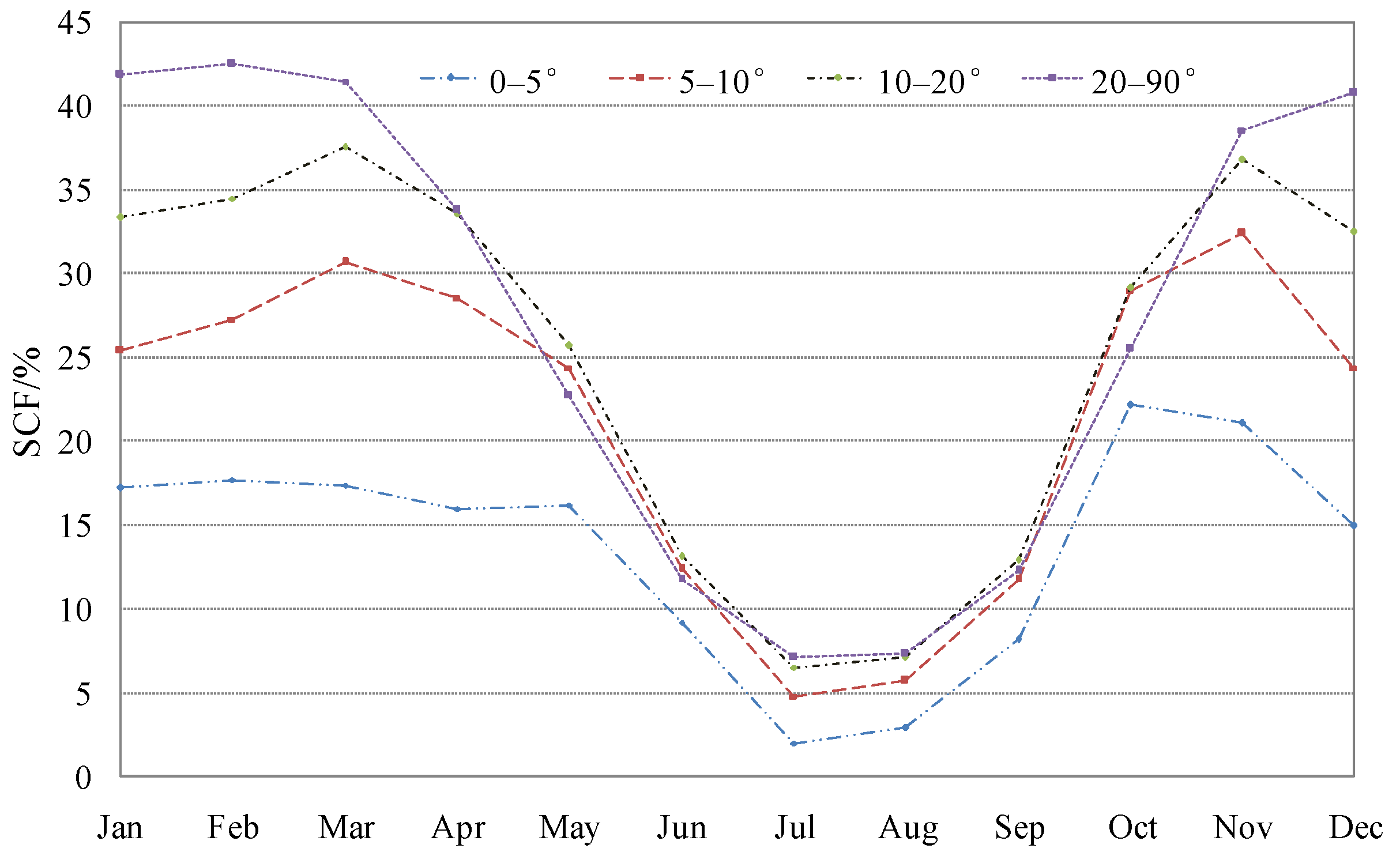
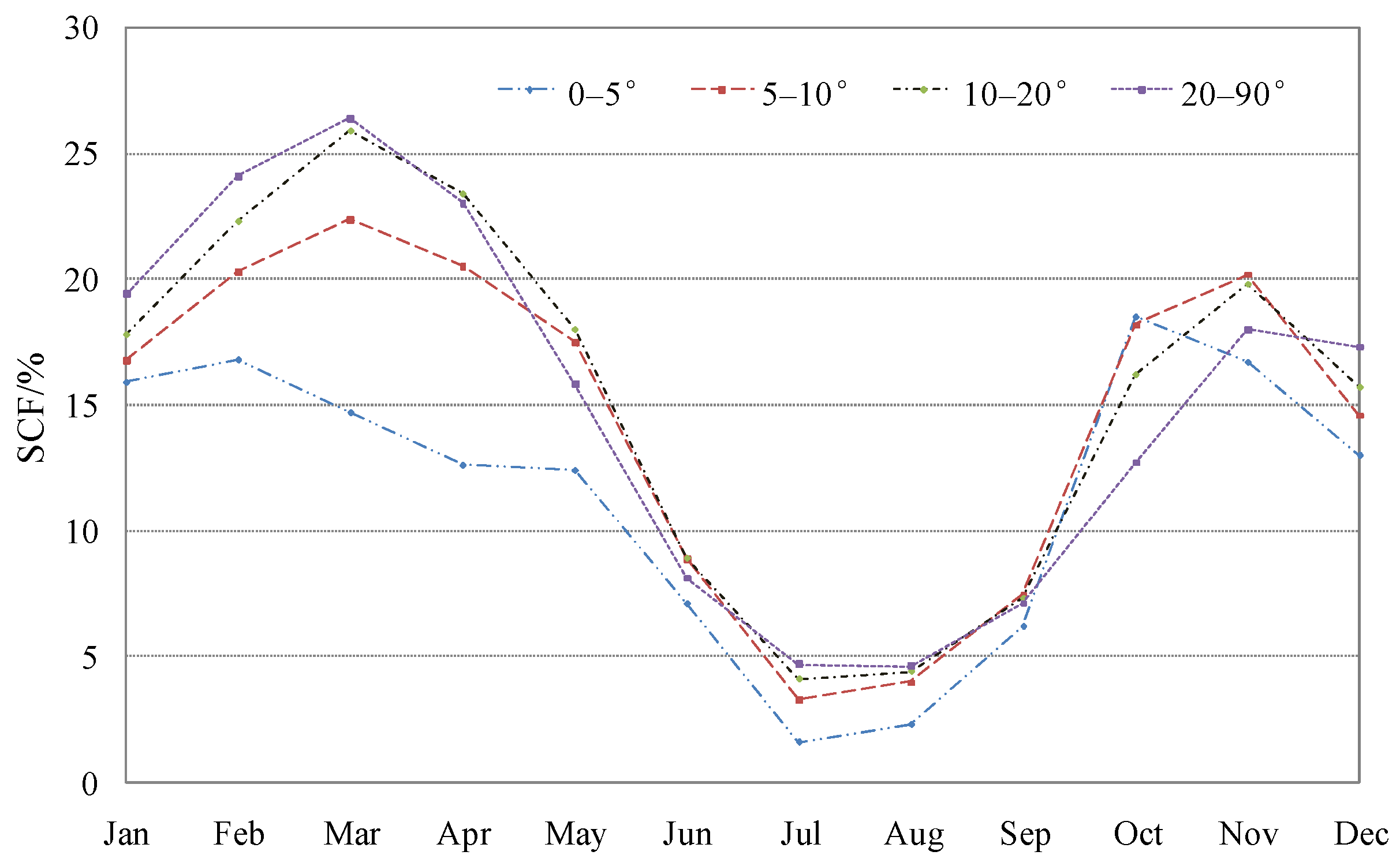
| No. | SCF range (%) |
SCF (%) | ||||
| Annual | Spring | Summer | Autumn | Winter | ||
| 1 | 0-10 | 49.9 | 44.2 | 87.8 | 47.3 | 42.1 |
| 2 | 11-20 | 24.5 | 20.7 | 6.6 | 20.8 | 25.3 |
| 3 | 21-30 | 11.2 | 11.7 | 2.2 | 13.0 | 11.9 |
| 4 | 31-40 | 5.7 | 6.9 | 0.9 | 8.2 | 6.2 |
| 5 | 41-50 | 3.4 | 4.4 | 0.5 | 4.6 | 4.0 |
| 6 | 51-60 | 2.1 | 3.2 | 0.3 | 2.6 | 2.9 |
| 7 | 61-70 | 1.1 | 2.8 | 0.3 | 1.1 | 2.3 |
| 8 | 71-80 | 0.8 | 2.2 | 0.3 | 0.6 | 2.0 |
| 9 | 81-90 | 0.9 | 2.1 | 0.4 | 0.6 | 1.8 |
| 10 | 91-100 | 0.3 | 1.6 | 0.8 | 1.3 | 1.5 |
| Mean SCF | 15.7 | 20.9 | 5.4 | 17.5 | 20.6 | |
| No. | Elevation range(km) | SCF (%) | CV | |||||||||||
| January | February | March | April | May | June | July | August | September | October | November | December | |||
| 1 | <1 | 6.2 | 2.3 | 0.6 | 0.2 | 0.2 | 0.5 | 0.3 | 0.6 | 1.5 | 0.7 | 0.6 | 2.7 | 1.3 |
| 2 | 1~2 | 15.7 | 7.5 | 2.2 | 0.4 | 0.4 | 0.4 | 0.5 | 0.8 | 1.2 | 1.3 | 3.8 | 11.8 | 1.3 |
| 3 | 2~3 | 10.2 | 8.2 | 5.5 | 1.7 | 0.8 | 0.6 | 0.5 | 0.7 | 1.1 | 2.4 | 5.4 | 8.2 | 0.9 |
| 4 | 3~4 | 19.6 | 20.2 | 18.7 | 10.8 | 5.8 | 1.1 | 0.8 | 1.0 | 2.4 | 8.7 | 16.1 | 15.7 | 0.8 |
| 5 | 4~5 | 21.8 | 23.9 | 24.3 | 21.4 | 16.5 | 6.7 | 1.7 | 2.3 | 6.3 | 21.5 | 25.5 | 19.7 | 0.6 |
| 6 | 5~6 | 23.1 | 27.6 | 32.7 | 35.0 | 35.1 | 23.1 | 8.7 | 10.0 | 19.1 | 35.1 | 31.2 | 22.4 | 0.4 |
| 7 | >6 | 48.0 | 52.2 | 76.9 | 90.0 | 90.8 | 84.2 | 76.6 | 77.8 | 84.7 | 90.6 | 83.7 | 60.4 | 0.2 |
| Mean | 20.8 | 22.8 | 23.8 | 21.2 | 17.9 | 9.3 | 3.4 | 4.1 | 8.4 | 20.9 | 23.5 | 18.8 | ||
| Aspect range(˚) |
SCF (%) | ||||||||||||||||
| Jan. | Feb. | Mar. | Apr. | May | Jun. | Jul. | Aug. | Sep. | Oct. | Nov. | Dec. | Annual | Spring | Summer | Autumn | Winter | |
| 315-45 | 23.9 | 24.8 | 25.9 | 23.3 | 20.2 | 10.8 | 3.8 | 4.6 | 10.1 | 25.2 | 27.8 | 22.3 | 18.5 | 23.0 | 6.2 | 20.9 | 23.5 |
| 45-135 | 20.5 | 23.2 | 24.8 | 21.9 | 18.1 | 9.5 | 3.7 | 4.3 | 8.5 | 20.7 | 23.8 | 18.7 | 16.4 | 21.5 | 5.7 | 17.6 | 20.6 |
| 135-225 | 16.7 | 19.1 | 19.3 | 17.1 | 14.8 | 7.9 | 2.7 | 3.2 | 6.7 | 16.6 | 18.1 | 14.2 | 12.9 | 17.0 | 4.4 | 13.7 | 16.5 |
| 225-315 | 22.2 | 24.3 | 25.5 | 22.9 | 18.8 | 9.3 | 3.5 | 4.2 | 8.6 | 21.7 | 25.0 | 20.0 | 17.1 | 22.3 | 5.5 | 18.4 | 22.0 |
| -1 | 16.9 | 17.6 | 17.2 | 13.8 | 8.3 | 2.8 | 0.6 | 0.7 | 1.1 | 2.7 | 8.3 | 14.5 | 8.6 | 13.0 | 1.3 | 4.0 | 16.2 |
| Slope range(°) |
SCF (%) | ||||||||||||||||
| Jan. | Feb. | Mar. | Apr. | May | Jun. | Jul. | Aug. | Sep. | Oct. | Nov. | Dec. | Annual | Spring | Summer | Autumn | Winter | |
| 0-5 | 16.9 | 23.0 | 16.8 | 14.8 | 14.4 | 8.0 | 1.0 | 2.6 | 7.1 | 19.4 | 19.2 | 14.3 | 12.7 | 15.3 | 4.0 | 15.1 | 16.2 |
| 5-10 | 21.6 | 19.8 | 27.7 | 25.5 | 21.3 | 10.6 | 2.0 | 5.0 | 9.6 | 23.7 | 26.9 | 19.9 | 18.4 | 24.7 | 6.4 | 20.0 | 21.8 |
| 10-20 | 25.6 | 24.2 | 32.7 | 29.5 | 22.3 | 11.0 | 3.0 | 5.9 | 10.2 | 22.9 | 28.9 | 24.2 | 20.6 | 28.1 | 7.2 | 20.6 | 26.0 |
| 20-90 | 30.1 | 28.7 | 34.3 | 29.0 | 19.5 | 9.8 | 4.0 | 5.9 | 9.6 | 18.9 | 28.3 | 28.7 | 21.0 | 27.4 | 6.9 | 18.8 | 30.4 |
| Aspect | Slope/° | Jan | Feb | Mar | Apr | May | Jun | Jul | Aug | Sep | Oct | Nov | Dec |
| Northward | 0–5 | 17.2 | 17.7 | 17.4 | 16.0 | 16.2 | 9.2 | 2.0 | 2.9 | 8.2 | 22.2 | 21.1 | 15.0 |
| 5–10 | 25.4 | 27.3 | 30.7 | 28.6 | 24.4 | 12.4 | 4.8 | 5.7 | 11.7 | 29.0 | 32.4 | 24.4 | |
| 10–20 | 33.4 | 34.5 | 37.6 | 33.6 | 25.7 | 13.1 | 6.5 | 7.1 | 12.9 | 29.2 | 36.8 | 32.5 | |
| 20–90 | 41.9 | 42.5 | 41.5 | 33.8 | 22.7 | 11.7 | 7.1 | 7.3 | 12.3 | 25.5 | 38.6 | 40.8 | |
| Eastward | 0–5 | 16.3 | 17.8 | 17.6 | 15.5 | 15.0 | 8.5 | 2.1 | 2.9 | 7.3 | 19.8 | 19.4 | 13.8 |
| 5–10 | 21.6 | 25.3 | 28.8 | 25.9 | 21.1 | 10.5 | 4.6 | 5.3 | 9.4 | 23.1 | 27.1 | 20.0 | |
| 10–20 | 24.9 | 28.7 | 32.8 | 29.1 | 21.7 | 10.9 | 5.6 | 6.0 | 9.9 | 21.9 | 28.5 | 23.7 | |
| 20–90 | 28.3 | 31.1 | 32.4 | 27.3 | 17.9 | 9.0 | 5.5 | 5.4 | 8.8 | 17.2 | 26.8 | 27.2 | |
| Southward | 0–5 | 15.9 | 16.8 | 14.7 | 12.6 | 12.4 | 7.1 | 1.6 | 2.3 | 6.2 | 18.5 | 16.7 | 13.0 |
| 5–10 | 16.8 | 20.3 | 22.4 | 20.5 | 17.5 | 8.9 | 3.3 | 4.0 | 7.5 | 18.2 | 20.2 | 14.6 | |
| 10–20 | 17.8 | 22.3 | 25.9 | 23.4 | 18.0 | 8.9 | 4.1 | 4.4 | 7.3 | 16.2 | 19.8 | 15.7 | |
| 20–90 | 19.4 | 24.1 | 26.4 | 23.0 | 15.8 | 8.1 | 4.7 | 4.6 | 7.1 | 12.7 | 18.0 | 17.3 | |
| Westward | 0–5 | 18.4 | 19.2 | 17.8 | 15.3 | 14.7 | 7.7 | 1.9 | 2.6 | 7.1 | 19.9 | 20.6 | 15.6 |
| 5–10 | 22.3 | 25.4 | 28.8 | 26.7 | 21.9 | 10.4 | 4.1 | 5.0 | 9.5 | 24.0 | 27.7 | 20.5 | |
| 10–20 | 25.8 | 29.4 | 34.1 | 31.4 | 23.5 | 11.2 | 5.3 | 5.9 | 10.4 | 23.8 | 29.7 | 24.3 | |
| 20–90 | 31.4 | 34.8 | 36.9 | 32.0 | 21.5 | 10.6 | 5.9 | 6.2 | 10.2 | 20.5 | 30.1 | 29.9 |
Disclaimer/Publisher’s Note: The statements, opinions and data contained in all publications are solely those of the individual author(s) and contributor(s) and not of MDPI and/or the editor(s). MDPI and/or the editor(s) disclaim responsibility for any injury to people or property resulting from any ideas, methods, instructions or products referred to in the content. |
© 2023 by the authors. Licensee MDPI, Basel, Switzerland. This article is an open access article distributed under the terms and conditions of the Creative Commons Attribution (CC BY) license (http://creativecommons.org/licenses/by/4.0/).





